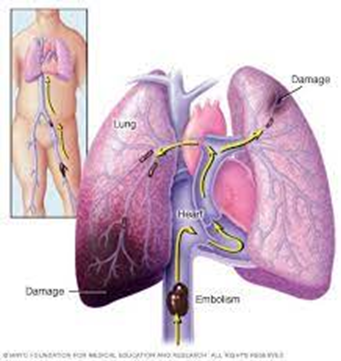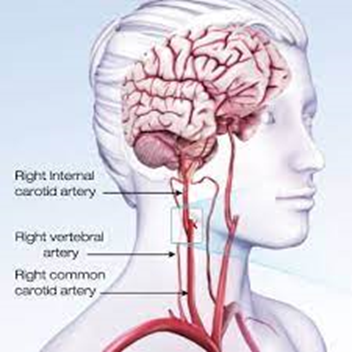A nurse is caring for a client who has a pulmonary embolism. The nurse should identify that the release of inflammatory mediators leads to which of the following pathologic findings?
Decreased pulmonary vascular resistance
Hypercapnia
Hypoventilation
Respiratory alkalosis
The Correct Answer is D
Correct answer: D
Choice A Reason:
Decreased pulmonary vascular resistance is incorrect. Inflammatory mediators released in response to a pulmonary embolism can lead to vasoconstriction and increased pulmonary vascular resistance. This is part of the body's response to redirect blood flow away from the affected area of the lung and maintain adequate perfusion to other areas.
Choice B Reason:
Hypercapnia is incorrect. Hypercapnia refers to elevated levels of carbon dioxide (CO2) in the blood. Hypocapnia usually is present with embolism; hypercapnia, on the other hand, is rare.
Choice C Reason:
Hypoventilation is incorrect. Hypoventilation occurs when there is inadequate ventilation of the lungs relative to metabolic demands. In the context of a pulmonary embolism, hypoventilation can occur due to factors such as pain, respiratory muscle fatigue, or impaired gas exchange, all of which can be influenced by the release of inflammatory mediators.
Choice D Reason:
Respiratory alkalosis is correct. In response to the blockage and the resulting inflammation, the body often increases the respiratory rate as a compensatory mechanism to maintain adequate oxygen levels and remove carbon dioxide. Due to the increased breathing rate, there is excessive exhalation of carbon dioxide, leading to a decrease in the partial pressure of CO2 in the blood. This results in an increase in blood pH, causing respiratory alkalosis.

Nursing Test Bank
Naxlex Comprehensive Predictor Exams
Related Questions
Correct Answer is ["A","D","E"]
Explanation
Choice A Reason:
Epithelial cells is correct. Epithelial cells lining the airways play a role in initiating the inflammatory response in asthma by releasing cytokines and other inflammatory mediators. These cells can contribute to the circulatory surge of inflammatory cells and cytokines seen in status asthmaticus.
Choice B Reason:
OT lymphocytes is incorrect. There is no specific cell type known as "OT lymphocytes." It's possible this may refer to T lymphocytes (T cells), which are involved in the immune response in asthma but are not typically associated with a circulatory surge in status asthmaticus.
Choice C Reason:
Hyperreactivity is incorrect. Hyperreactivity refers to the exaggerated response of the airways to various stimuli, leading to bronchoconstriction and inflammation. While hyperreactivity is a characteristic feature of asthma, it does not directly contribute to a circulatory surge of inflammatory cells and cytokines.
Choice D Reason:
Mast cells is correct. Mast cells are key players in the pathophysiology of asthma. They release various inflammatory mediators, including histamine and leukotrienes, which contribute to airway inflammation, bronchoconstriction, and mucus production. Mast cells can participate in the circulatory surge of inflammatory cells and cytokines in status asthmaticus.
Choice E Reason:
Inflammation is correct. Inflammation is a hallmark feature of asthma and plays a central role in the pathogenesis of status asthmaticus. The inflammatory response involves the recruitment and activation of various inflammatory cells, release of cytokines, and other mediators that contribute to airway obstruction and systemic effects.
Correct Answer is C
Explanation
Choice A Reason:
Prothrombin time (PT) is a laboratory test that measures the time it takes for blood to clot is incorrect. While PT may be part of a comprehensive evaluation in some cases, it is not typically the initial diagnostic test performed for a TIA. A TIA is caused by a temporary disruption of blood flow to the brain, often due to an embolus or transient blockage in a cerebral artery, rather than a primary disorder of blood clotting.
Choice B Reason:
Complete blood count (CBC) is incorrect. A complete blood count (CBC) is a common laboratory test that evaluates the cellular components of the blood, including red blood cells, white blood cells, and platelets. While CBC can provide valuable information about hematological conditions such as anemia or thrombocytosis, it is not specific to diagnosing the cause of a TIA. TIA is primarily a vascular event related to transient ischemia in the brain rather than a disorder of blood cell counts.
Choice C Reason:
Computerized tomography angiography (CTA) is appropriate. CTA is a non-invasive imaging test that combines computed tomography (CT) scanning with contrast dye to visualize blood vessels throughout the body, including those in the brain. CTA can help identify any blockages, narrowing, or abnormalities in the blood vessels supplying the brain, which may be contributing to the TIA. It provides detailed images of the blood vessels' structure and can help guide further management and treatment decisions.
Choice D Reason:
Transesophageal echocardiogram (TEE) is inappropriate. Transesophageal echocardiogram (TEE) is an imaging test that provides detailed images of the heart and major blood vessels using sound waves. While TEE may be indicated in some cases of TIA to evaluate for potential cardiac sources of emboli (blood clots), such as atrial fibrillation or cardiac valve abnormalities, it is not typically the first-line diagnostic test performed in the emergency department setting for evaluating a TIA. Initial imaging studies such as CTA or magnetic resonance imaging (MRI) of the brain are usually prioritized to assess for acute changes in cerebral blood flow and potential causes of the TIA.

Whether you are a student looking to ace your exams or a practicing nurse seeking to enhance your expertise , our nursing education contents will empower you with the confidence and competence to make a difference in the lives of patients and become a respected leader in the healthcare field.
Visit Naxlex, invest in your future and unlock endless possibilities with our unparalleled nursing education contents today
Report Wrong Answer on the Current Question
Do you disagree with the answer? If yes, what is your expected answer? Explain.
Kindly be descriptive with the issue you are facing.
